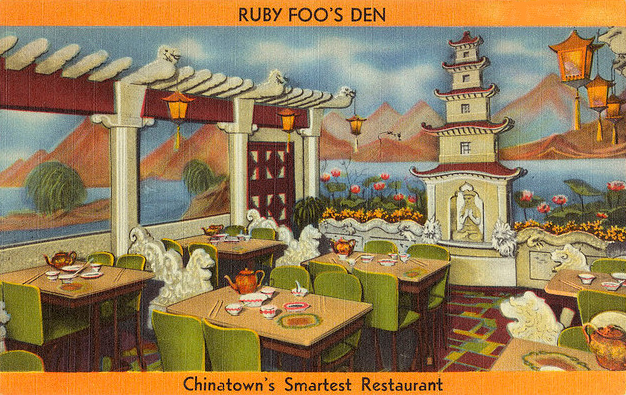Ruby Foo, Behind the scene of celebrated Chinese restaurateur
Posted by John Jung on Saturday, June 1, 2019,
In :
Chinese restaurants
King Joy Lo, Early Elegant Banquet Restaurant in Chicago
Posted by John Jung on Tuesday, June 19, 2018,
In :
Chinese restaurants
Selling The American Public On Eating in Chinese Restaurants
Posted by John Jung on Friday, April 20, 2018,
In :
Chinese restaurants
What's In A Name of A Chinese Restaurant?
Posted by John Jung on Thursday, April 14, 2016,
In :
Chinese restaurants
Origin of the Chinese Restaurant Container for Leftovers?
Posted by John Jung on Saturday, February 13, 2016,
In :
Chinese restaurants
Joy Young Restaurant, Augusta, Georgia
Posted by John Jung on Wednesday, November 4, 2015,
In :
Chinese restaurants
The Sun Is Setting on Mom and Pop Chinese restaurants
Posted by John Jung on Thursday, September 17, 2015,
In :
Chinese restaurants
Imperial Dynasty, China Alley, Hanford, CA.
Posted by John Jung on Friday, September 4, 2015,
In :
Chinese restaurants
Eating His Way Through Chinatowns of America
Posted by John Jung on Friday, October 25, 2013,
In :
Chinese restaurants
Who Ate What in Early Chinatown Cafes?
Posted by John Jung on Sunday, October 20, 2013,
In :
Chinese restaurants
Cleveland Chinese Restaurants of the First Half of the 20th Century
Posted by John Jung on Wednesday, February 6, 2013,
In :
Chinese restaurants
Hung Far Low Restaurant in Grand Rapids, MI
Posted by John Jung on Monday, July 30, 2012,
In :
Chinese restaurants
Memories of Chinese Canadian Restaurant Food 1940s-50s
Posted by John Jung on Monday, July 2, 2012,
In :
Chinese restaurants
Chinese Restaurants: Boxed In By Low Prices?
Posted by John Jung on Friday, June 29, 2012,
In :
Chinese restaurants
Chop Suey in Augusta, Georgia 1905
Posted by John Jung on Wednesday, April 18, 2012,
In :
Chinese restaurants
Study of Chinese Impact on Small Town Canadian Culture Via Chinese Cafe Menus
Posted by John Jung on Saturday, March 31, 2012,
In :
Chinese restaurants
Chinese restaurants in Israel
Posted by John Jung on Tuesday, February 15, 2011,
In :
Chinese restaurants
Life at a Chinese take-out order counter
Posted by John Jung on Tuesday, February 8, 2011,
In :
Chinese restaurants
A Century of Fads and Fashions in Chinese Food
Posted by John Jung on Thursday, January 6, 2011,
In :
Chinese restaurants
Joy Young Restaurant, Birmingham
Posted by John Jung on Thursday, January 6, 2011,
In :
Chinese restaurants
A 5 Star Chinese Restaurant in rural Hanford, Ca.
Posted by John Jung on Thursday, January 6, 2011,
In :
Chinese restaurants
Far East Cafe in Little Tokyo, Los Angeles
Posted by John Jung on Thursday, January 6, 2011,
In :
Chinese restaurants
The high cost of Anglo humor re: a Chinese restaurant name
Posted by John Jung on Thursday, January 6, 2011,
In :
Chinese restaurants
Chinese restaurants spring up everywhere in the 1920s
Posted by John Jung on Friday, March 12, 2010,
In :
Chinese restaurants
About Me
| John Jung |
| Cypress, Ca. |
 After retiring from a 40-year career as a psychology professor, I published 4 books about Chinese immigrants that detail the history of their laundries, grocery stores, and family restaurants in the U. S. and Canada.
After retiring from a 40-year career as a psychology professor, I published 4 books about Chinese immigrants that detail the history of their laundries, grocery stores, and family restaurants in the U. S. and Canada.
|
Tags
10-2 1920s act alabama alameda alley alliete and arianne ask association auckland augusta australian authenticity ave. birmingham bodard books bookstore box ca cafe cafes california calls calvin canada canadian canned carina cerritos chan chang charles chicago chin china chinatown chinese chinese dishes chinese soul food chinese: cho chop chow choy chu chun cleveland co. columbian conditions connie container cookbooks cookie cooking cowen cuisine culinary culture david de diego dim din dog dumplings dynasty early eating economics exclusion exhibition f. family far flexible foin foo foo's food fortune fried fujianese fung gabriel georgia google grace grand haiming hanford hayford hilgers historians historical history ho hotels huang hung imogene imperial in israel italy jews joe joy kartie kimg king korea kwok la larry lauren lee leftovers leong li library lily lim liu liz lo louie low ma mein melbourne menu merchants michigan movement museum names new ngalan ngram northern of ohio omnivore on oregon origins paper portland prank prices public rapids reform relatives restaurant restaurants restaurateur rice richard rockwell ruby s. salisbury samoa san sandwich saskatchewan shanghai side small snakeheads sour stereotypes suey sum sunshine suzanne sweet tai take-out takeout tam teachers telephone the tong town trillin tsang tyler valley vancouver vietnamese village w. wing wong workers working world's writers young zealand zia 1893













